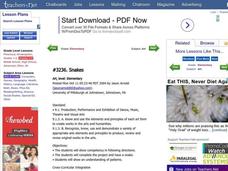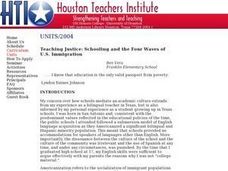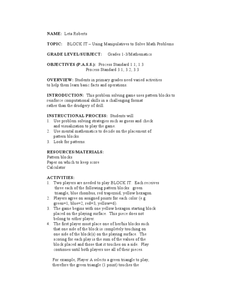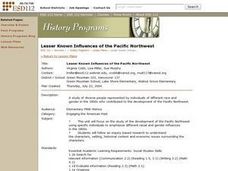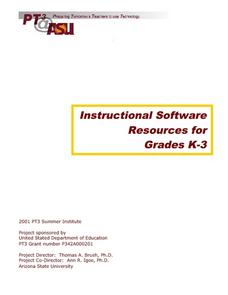National Wildlife Federation
Massive Migrations
Turn your students into flocks of migratory birds for this fun activity on animal migration. Prior to the activity, the teacher creates four different migration routes in the classroom or any available open space, labeling nesting...
Curated OER
Math Quilts
Students examine geometric shapes. In this geometric shape lesson plan, students examine how geometric shapes flip, turn, and slide to create a pattern. Students analyze the role that quilts played in helping slaves escape to freedom. ...
Curated OER
Snakes
Students follow directions to make a snake out of patterns. They research a specific snake and present it to the class in a group. They listen to a presentation about the King Cobra snake prepared by the teacher.
Curated OER
Tiling the Plane
Students use pattern blocks and triangular grid paper to review shape names, be introduced to the concept of a tiling of the plane, and determine which pattern blocks tile the plane. They are asked: "Have you ever seen a floor or a wall...
Curated OER
Storms and Extreme Weather
Students explore hurricanes and tornadoes by conducting an experiment. For this weather pattern lesson, students define many extreme weather vocabulary terms and discuss the relationship with static electricity. Students utilize plastic...
Curated OER
Teaching Justice: Schooling and the Four Waves of U.S. Immigration
U.S. immigration is the focus of a unit on social justice. Over the course of a school year, young historians read a variety of texts to learn about four waves of immigration that have occurred over time in the U.S. An emphasis on...
Curated OER
Multiplication Magic
Investigate multiplication problem solving strategies by working with base 10 blocks. Learners decompose problems with a Merlin the Magician theme. Multiple resources are provided.
Curated OER
Block It: Using a Manipulative to Solve Math Problems
Learners practice using visuals to solve math problems. In this math manipulative lesson, students utilize pattern blocks to participate in a class game in which geometric shapes touch other player's pieces. Learners gain points based on...
Curated OER
Ornithology and Real World Science
Double click that mouse because you just found an amazing instructional activity! This cross-curricular Ornithology instructional activity incorporates literature, writing, reading informational text, data collection, scientific inquiry,...
Curated OER
Tall Tale Rollers
Students explore American tall tales. In this tall tale lesson, students discover the six characteristics that are included in tall tales. Students survey their class to find each student's favorite tall tale character and organize the...
Curated OER
"Where Does Pi Come From?"
Fifth graders explore geometry by exploring Pi. In this circle measurement lesson, 5th graders identify the relationship between the radius, diameter and circumference of a circle and how Pi is the key to unlocking any circular...
Curated OER
Once in a Blue Moon
Third graders identify the phases of the moon. They use technology to access websites on the Internet dealing with the moon.
Curated OER
Where Have All the Endangered Gone?
Students explore animals that are endangered. They choose an endangered animal that they would like to keep from becoming extinct. Students create a persuasive presentation to persuade someone to understand why they feel keeping their...
Curated OER
Wonderful, Wild Weather
Students study the different types of weather, how it affect what they wear, and how it is related to the seasons. They compare the seasons and tell how they prepare for the change in seasons. They design a creative presentation about...
Curated OER
Calder's Balancing Acts
Students learn the vocabulary of contemporary sculpture and distinguish between abstract and realistic sculpture, mobile and stabile, biomorphic and geometric. They write equations using Calder's mobiles
Curated OER
"How Do You Measure Up?"
Fourth graders explore basic measurements by analyzing their own bodies. In this human anatomy lesson, 4th graders identify the units used to measure a human body such as centimeters, inches, ounces and pounds. Students complete a...
Curated OER
Eggs'ceptional Experiments
Students see evidence of chemical reaction and follow the scientific method to hypothesize, observe, and reach conclusions. They conduct a series of egg based experiments such as forming crystals and complete journal activities as a...
Curated OER
Families and Communities
Here is a week-long lesson on the roles of family members designed for first graders. In it, learners share stories of their families, listen to books about families read to them by their teacher, complete homework assignments and...
Curated OER
Animals, Animals, Everywhere
Fourth graders participate in a variety of activities dealing with animal characteristics and classifications in this multi-task lesson. They use graphic organizers, make booklets, and make models.
Curated OER
Descriptive Paragraphs
Third graders gain the necessary skills to write a descriptive paragraph. They see the evaluation and decision making process that are used in good wriitng. The bible is used to see illustrations and then used to paint a picture in...
Curated OER
Changing Images of Childhood in America: Colonial, Federal and Modern England
Students compare and contrast maps of New Haven, Connecticut from today and the past. After taking a field trip, they draw sketches of the types of architecture and discuss how the buildings have changed over time. They read journal...
Curated OER
Lesser Known Influences of the Pacific Northwest
Students engage in research about the development of the Pacific Northwest using specific individuals to emphasize different racial and gender influences in the 1800's. The research method that is used is inquiry based.
Curated OER
Tree Search
Fifth graders plan and conduct investigations to identify and record tree species. They complete Forest Plotter and write about tree species found and draw pictures of them.
Curated OER
Instructional Software Resources for Grades K-3
Learners become familiar with teh selection, evaluation, and use of instructional software for 4-8 classroom. They download software demos from the web and discuss critiquing software. Students browse software evaluations on web sites.


